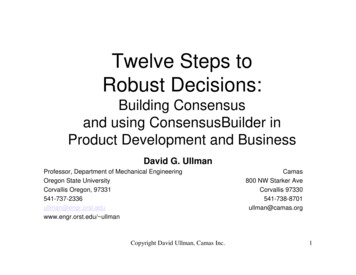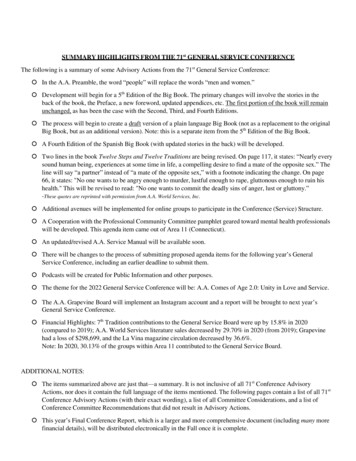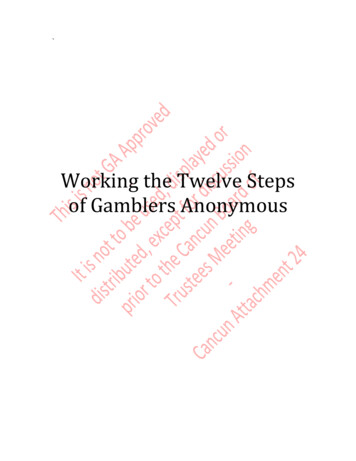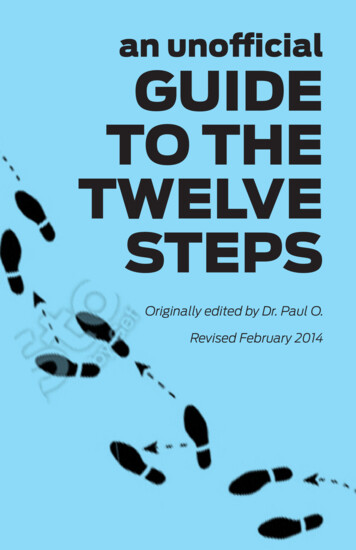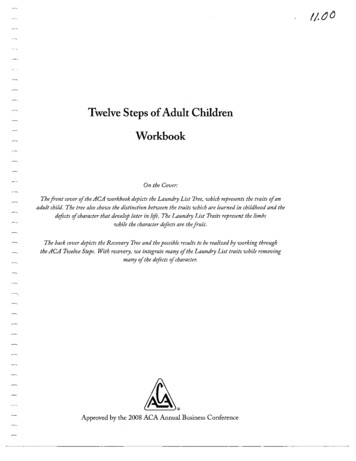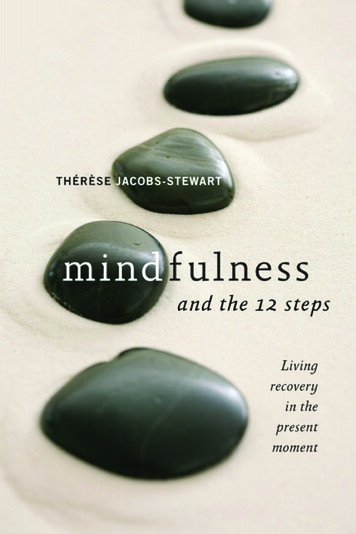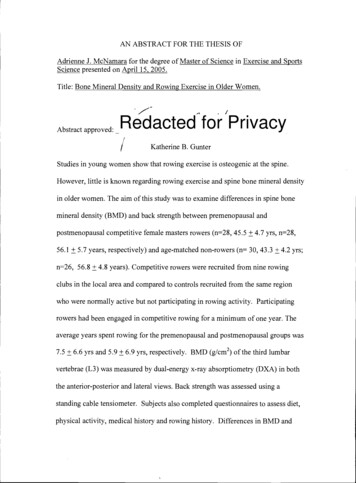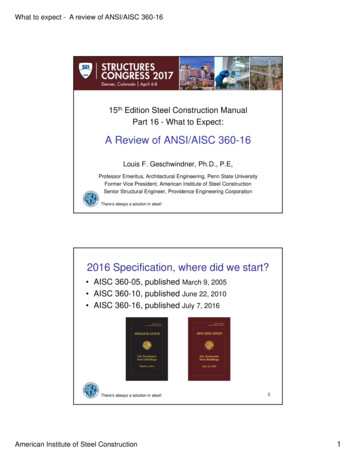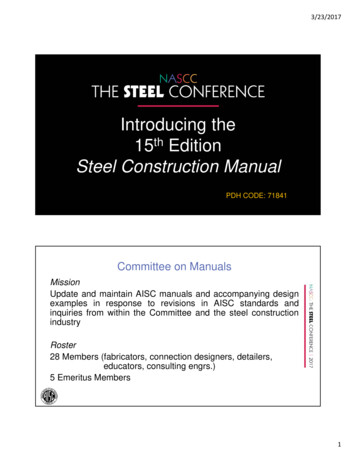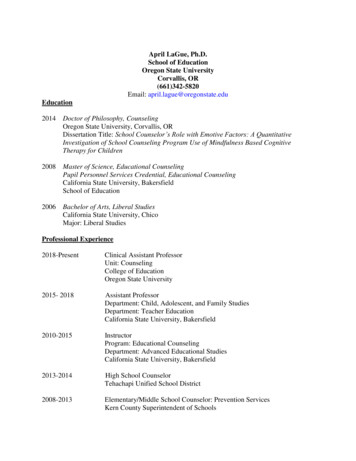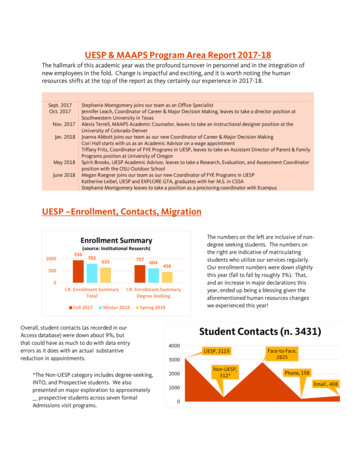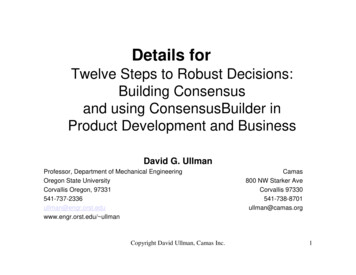
Transcription
Details forTwelve Steps to Robust Decisions:Building Consensusand using ConsensusBuilder inProduct Development and BusinessDavid G. UllmanProfessor, Department of Mechanical EngineeringOregon State UniversityCorvallis Oregon, .edu/ ullmanCopyright David Ullman, Camas Inc.Camas800 NW Starker AveCorvallis 97330541-738-8701ullman@camas.org1
12 Steps to Robust DecisionsStep 1. Maximize personal decision-making effectiveness.Step 2. Insure team and organization effectiveness.Step 3. State the issue.Step 4. Identify the customers.Step 5. Itemize solution features.Step 6. Define targets for the features.Step 7. Measure feature importance.Step 8. Generate alternative solutions.Step 9. Measure decision-makers’knowledge.Step 10. Determine belief in alternatives’ability to meet targets.Step 11. Determine overall satisfaction in alternatives.Step 12. Decide what to do next.Copyright David Ullman, Camas Inc.2
Robust decision-making works to minimizethe risk resulting from choosing a pooralternative1.2.3.4.5.6.7.The risk resulting from not being able to solve the problemor Decision-Maker RiskThe risk resulting from not getting the best from the problemsolvers or Organizational RiskThe risk resulting from solving the wrong problem orEnvisioning RiskThe risk resulting from not developing good alternatives orIdeation RiskThe risk resulting from choosing a poor alternative orEvaluation RiskThe risk resulting from not following a beneficial strategy orStrategic RiskThe risk resulting from not being able to implement thedecision or Execution RiskCopyright David Ullman, Camas Inc.3
The 12 Steps1Prepare theDecision-Makers23Clarifythe Issue47651: Decision-maker 09-11: Evaluation risk12Decide whatto do next12.23-7: Envisioning risk6: Ideation risk11EvaluateAlternativesUsing Criteria2: Organizational risk12.31,2,12: Strategic risk12.1a12: Realization riskDocumentDecision12.512.7AddressNew IssuesCopyright David Ullman, Camas Inc.4
Problem Solver RiskThe risk resulting from decision-maker ineffectiveness.Strategic RiskThe risk resulting from not following a beneficial strategyStep 1: Maximize Personal DecisionMaking EffectivenessIndividual Decision-Making Success Decision-Making Style Decision-Making Strategy Issue Knowledge Copyright David Ullman, Camas Inc.5
Problem Solver RiskThe risk resulting from decision-maker ineffectiveness.Strategic RiskThe risk resulting from not following a beneficial strategyStep 1: Maximize Personal DecisionMaking Effectiveness1.1 Be aware of decision-making style.1.2 Use sound decision-making strategy1.3 Be aware of issue knowledge.Copyright David Ullman, Camas Inc.6
Problem Solver RiskThe risk resulting from decision-maker ineffectiveness.Strategic RiskThe risk resulting from not following a beneficial strategy1.1 Be aware of decision-making style.Decision-Making Style Energy Source Information Management Style Information Language Deliberation Style Decision Closure StyleCopyright David Ullman, Camas Inc.7
Problem Solver RiskThe risk resulting from decision-maker ineffectiveness.INTERNALENERGY SOURCE01.2.3.4.5.1234EXTERNAL5In a group, do you generally wait to be introduced introduce othersDoes interacting with others take real effort energize youDo you tend to listen and reflect say what is on your mindDo you think of yourself as private outgoingAt work do you tend keep more to yourself be sociable with your colleaguesCopyright David Ullman, Camas Inc.8
Problem Solver RiskThe risk resulting from decision-maker MATION MANAGEMENT STYLE12345Which word best describes you practical ingeniousWhich interest you more the actual the possibleIn problem solving, do you prefer to iron out the details develop the ideasAre you inclined to take what is said literally figurativelyDo you generally feel down to earth somewhat removedCopyright David Ullman, Camas Inc.9
Problem Solver RiskThe risk resulting from decision-maker ineffectiveness.VISUALINFORMATION LANGUAGE01234VERBAL51. When you meet someone again, do you remember their face name2. Do you prefer to be shown how read instructions how3. In a book, if there are two descriptions of the same material,which do you look at first a diagram the text4. If they both represented the same thing, would you rather study a graph an equation5. If there is a possibility to touch an object you do so eagerly you hold backCopyright David Ullman, Camas Inc.10
Problem Solver RiskThe risk resulting from decision-maker ineffectiveness.SUBJECTIVEDELIBERATION STYLE01.2.3.4.5.1234OBJECTIVE5Do you more often let your heart rule your head your head rule your heartWhich is the worse fault to be unsympathetic to show too much concernWhich to you most value in yourself your compassion your reasonWhich appeals to you more harmonious relationships getting the job doneIn a heated discussion, do you look for common ground usually stick to your gunsCopyright David Ullman, Camas Inc.11
Problem Solver RiskThe risk resulting from decision-maker ineffectiveness.FLEXIBLEDECISION CLOSURE STYLE01.2.3.4.5.1234DECISIVE5Do you prefer to just let things happen plan for things to happenWhen a decision is to be made, are you more comfortable before afterIs it harder for you to adapt to routine ChangeIn you more satisfied with work in progress a finished productAre more impulsive carefulCopyright David Ullman, Camas Inc.12
Strategic RiskThe risk resulting from not following a beneficial strategy1.2 Use sound decision-making strategyDesigners who use an effective strategy:§Spend time understanding the issues and developingcriteria§Consider multiple alternatives during the process§Keep options open as long as possible§Gather sufficient information to learn as you go§Iterate through the decision-making process§Be skeptical of information§Be aware of what you know and don’t knowCopyright David Ullman, Camas Inc.13
Strategic RiskThe risk resulting from not following a beneficial strategy1.3 Be aware of issue knowledge.See Steps 9, 10 and 11.Copyright David Ullman, Camas Inc.14
Organizational RiskThe risk resulting form anineffective team or organizationStep 2: Insure Team andOrganization EffectivenessTeam Decision-Making Success Shared Vision Mix of Individual Decision-making Styles Team Roles Team Structure Team Strategy Management StyleCopyright David Ullman, Camas Inc.15
Organizational RiskThe risk resulting form an ineffective team or organizationStep 2: Insure Team andOrganization Effectiveness2.1 Encourage development of a sharedvision.2.2 Encourage methods to get the best fromthe mix of decision-making styles.2.3 Balance team roles.2.4 Utilize an effective team structure.2.5 Adopt a front loaded strategy.2.6 Adopt a collaborative organization style.Copyright David Ullman, Camas Inc.16
Organizational RiskThe risk resulting form an ineffective team or organization2.1 Encourage development of a shared vision.Shared InformationIssue understandingalternativescriteriaStrategy usedEvaluation resultsDecisions reachedNOT Shared, butrespected andleveragedCriteria yCopyright David Ullman, Camas Inc.17
Organizational RiskThe risk resulting form an ineffective team or organization2.2 Encourage methods to get the bestfrom the mix of decision-making styles.INTERNALENERGY SOURCEEXTERNALThe twelve steps: Help team members who get their energy from within sharemore than their final response. Give internal decision-makers a more equal say indeliberations. Encourage external decision-makers to hear the contributionsof others.Copyright David Ullman, Camas Inc.18
Organizational RiskThe risk resulting form an ineffective team or organizationFACTSINFORMATION MANAGEMENT STYLEPOSSIBILITIESThe twelve steps: Encourage fact-oriented team members to allow the team towork on understanding the problem rather than diving right inand working on the details of a single, potential non-robustsolution. Encourage possibility-oriented team members to deal withdetails. Encourage possibility-oriented team members to be specificand avoid generalities. Help possibility-oriented team members to stick to the issues.Copyright David Ullman, Camas Inc.19
Organizational RiskThe risk resulting form an ineffective team or organizationVISUALINFORMATION LANGUAGEVERBALThe twelve steps: Help identify information that needs to becommunicated regardless of language. Help identify differences in team members’mentalmodels encouraging extra effort by both visual andverbal people to communicate clearly with otherteam members.Copyright David Ullman, Camas Inc.20
Organizational RiskThe risk resulting form an ineffective team or organizationSUBJECTIVEDECISION OBJECTIVITYOBJECTIVEThe twelve steps: Help subjective team members to discuss differences ofopinion without feeling threatened.Help the team reach consensus reassuring subjectivedecision-makers.Help objective team members understand and respecthow the team functions.Copyright David Ullman, Camas Inc.21
Organizational RiskThe risk resulting form an ineffective team or organizationFLEXIBLEPROBLEM CLOSUREDECISIVEThe twelve steps: Give both flexible and decisive team members a strategyso they can see that problems are solved one step at atime. Encourage feedback from other team members so flexibledecision-makers can reflect on the decision-makingprocess. Slow flexible decision-makers from changing their minds. Slow decisive decision-makers from jumping toconclusions without considering the details or other teammembers. Encourages decisive team members to be part of the datacollection and review process. Remind decisive team members that they are not alwaysright.Copyright David Ullman, Camas Inc.22
Organizational RiskThe risk resulting form an ineffective team or organizationSolverEvaluatorMotivatorMember 1Member 2Member onds2.3 Balance team roles.Copyright David Ullman, Camas Inc.23
Organizational RiskThe risk resulting form an ineffective team or organization2.4 Utilize an effective team structure.70Functional60Functional Matrix50Balanced MatrixProject Matrix40Project Team30OverallTechnicalCost20SchedulePercent Success80Copyright David Ullman, Camas Inc.24
Organizational RiskThe risk resulting form an ineffective team or organizationChanges 2.5 Adopt a front loaded strategy.TimeCopyright David Ullman, Camas Inc.25
Organizational RiskThe risk resulting form an ineffective team or organization2.6 Adopt a collaborative organization style. Running out of CollaborationCopyright David Ullman, Camas Inc.26
Envisioning RiskThe risk resulting from solving the wrong problemEnvisioning Understanding the ProblemStep 3. State the issue.Step 4. Identify the customers.Step 5. Itemize solution features.Step 6. Define targets.Step 7. Measure importance.The Developmentof CriteriaCopyright David Ullman, Camas Inc.27
Must know issue and criteria for a robustdecisionIssueNOISESCriteria Description of asatisfactory solutionEvaluateAlternatives andDecideA selectedalternativeAlternativesCopyright David Ullman, Camas Inc.28
Envisioning RiskThe risk resulting from solving the wrong problemStep 3: Identify the Issue.An issue is the current focus of problem solvingrequiring the development of new information. Adecision made about an issue is generally a call foraction dependent on the selection of an option oractivity to satisfy some criteria associated with theissue.Copyright David Ullman, Camas Inc.29
Envisioning RiskThe risk resulting from solving the wrong problemSome issues are: Design a front suspension system for a bicycle.What car should I buy? I want to go fast, in comfort.What should I do next on this project?How can we keep the brakes from squealing and stillhave good deceleration?What are we going to do about Bob? He seems sodisruptive.Find the best employee from the local talent pool forthe new marketing position.Where is the best place for our new factory?What is the best Java applet to change the cursorcolor?Copyright David Ullman, Camas Inc.30
Envisioning RiskThe risk resulting from solving the wrong problemIssue Object or process Characteristic Action Initial Criteria Initial Alternatives Source3.1 Identify the object, or process of interest.3.2 Identify the specific characteristic of the object orprocess on which action is needed.3.3 Identify desired action.Copyright David Ullman, Camas Inc.31
Envisioning RiskThe risk resulting from solving the wrong problem Bicycle front suspension system designCar chooseProject next step chooseBrakes changeBob change situationNew marketing employee findNew plant location findCursor color Java applet findCopyright David Ullman, Camas Inc.32
Envisioning RiskThe risk resulting from solving the wrong problem3.4 Itemize the initial criteria.3.5 Capture initial alternative solutions.3.6 Identify the source of the issue.– Direct Issue decomposition– Alternative generated issues– Criteria generated issueCopyright David Ullman, Camas Inc.33
Envisioning RiskThe risk resulting from solving the wrong problem3.7 Write a single sentence that describes theissue, question, task, problem statement orarea of concern.Copyright David Ullman, Camas Inc.34
Envisioning RiskThe risk resulting from solving the wrong problemStep 4: Identify the customers for ersCopyright David Ullman, Camas Inc.Others35
Envisioning RiskThe risk resulting from solving the wrong problem4.1 Itemize everyone who is included inthe description of the problem.4.2 Itemize everyone who comes in contactwith the object, function or processduring each phase of its life-cycle.Copyright David Ullman, Camas Inc.36
Business Life Cycle PhasesIdentify needDevelop needed materialto implement processPlan for decisionmaking processDistribute materials toimplement processDevelop CriteriaImplementDevelop alternativeplans of actionSelect a planof actionUse processRetire theprocessMaintainCopyright David Ullman, Camas Inc.37
Mechanical Product life Cycle PhasesCopyright David Ullman, Camas Inc.38
Envisioning RiskThe risk resulting from solving the wrong problemEnvisioning Understanding the ProblemStep 3. State the issue.Step 4. Identify the customers.Step 5. Itemize solution features.Step 6. Define targets.Step 7. Measure importance.The Developmentof CriteriaCopyright David Ullman, Camas Inc.39
Truths about CriteriaIf you don’t write down the criteria, they will changeduring problem solving – in product development thisis commonly called “feature creep.”If you don’t know what defines a satisfactory solution,the only way you know you are done is when you runout of time.If you don’t articulate the criteria, different teammembers will be working toward different goals(trying to meet different criteria) while believing theyare working together on the same issue.If you are not careful, you will not make good use of thefact that no two problem-solvers on a team believethe same criteria are important.Copyright David Ullman, Camas Inc.40
Envisioning RiskThe risk resulting from solving the wrong problemPercent of timeSome experimental results9876543210405060708090Technical QualityCopyright David Ullman, Camas Inc.41
Envisioning RiskThe risk resulting from solving the wrong problemStep 5: Itemize the important features of asolution.Criteria are used to measure features ofalternatives. As such they define goals for thefeatures, and relate the importance of meeting thesegoals.Criteria Feature Target ImportanceCopyright David Ullman, Camas Inc.42
Envisioning RiskThe risk resulting from solving the wrong problem5.1 List the features included in the issue statement.5.2 Add features based on those of previous andcompetitive solutions to similar problems.5.3 Refine feature list by listening to voice of thecustomers––––ObservingSurveysFocus GroupsComplaint historiesCopyright David Ullman, Camas Inc.43
Envisioning RiskThe risk resulting from solving the wrong problem5.4 Develop and use feature checklists to aid in completeness.Business project checklistFunctional performanceflow of informationoperational stepsoperational sequenceHuman factorsEase of sensing stateReliabilityOperation under variousconditionsLifecycle concernsDevelopment of materialDistribution of materialMaintainabilityRetirementResource concernsROICapital neededtimeUnit costsequipmentStandardsCopyright David Ullman, Camas Inc.44
ME Criteria checklistLife cycle concernsdistribution (shipping)Functional performancemaintainabilityflow of energydiagnosabilityflow of informationtestabilityflow of materialsrepairabilityoperational stepscleanabilityoperation sequenceinstallabilityHuman factorsretirementappearanceforce and motion to controlResource concernstimeease of controling and sensing statecost: capital and unitPhysical Requirementsequipmentavailable spatial envelopeStandardsphysical propertiesEnvironmentalReliabilitymean time between failuresManufacture/assembly Requirementssafety (hazard assessment)materialsquantitycompany capabilitiesCopyright David Ullman, Camas Inc.45
Envisioning RiskThe risk resulting from solving the wrong problem5.5 Refine the list of features to insure that thecriteria are discriminatory.Customer ntFullyImplementedsicBaDisgustedFunctionCopyright David Ullman, Camas Inc.46
Envisioning RiskThe risk resulting from solving the wrong problem5.6 Refine the list of features to insurethat the criteria are measurable.5.7 Refine the list of features to insurethat the criteria are orthognal.5.8 Refine the list of features to insurethat the criteria are universal.5.9 Refine the list of features to insurethat the criteria are external.Copyright David Ullman, Camas Inc.47
Envisioning RiskThe risk resulting from solving the wrong problemStep 6: Define targets for features.Identify the basis for evaluation.Criteria Characteristic Target Importance(basis goal (value units type realizability volatility sensitivity) condition)Copyright David Ullman, Camas Inc.48
Envisioning RiskThe risk resulting from solving the wrong problem6.1 Identify the basis for evaluation.Absolute targets The front suspension should weigh less than 220 gramsRelative targets The front suspension should weigh less than the Stoneshok 220.Implied targets The front suspension should be the lightest possible.Copyright David Ullman, Camas Inc.49
Envisioning RiskThe risk resulting from solving the wrong problem6.2. Identify the target goal value and units.6.3 Identify the target goal type.Goal valueTypeAbsoluteRelativeImpliedSetSet bybaselineUnstatedY/NEqualsExactAboutLess thanMore thanY/NEqualsExactAboutLess thanMore thanFunction ofLess the betterMore thebetterWeak criteriaCopyright David Ullman, Camas Inc.50
Envisioning RiskThe risk resulting from solving the wrong problem6.4. Identify the target goal realizability.6.5. Identify the target goal volatility.6.6. Identify the target goal value sensitivity.6.7. Identify conditions on the criterion.Copyright David Ullman, Camas Inc.51
Envisioning RiskThe risk resulting from solving the wrong problemStep 7: Measure characteristic importance foreach customer.7.1 Plan methods to honor various customerviewpoints.7.2 Measure importance from each customerviewpoint using the fixed sum or rankingmethod.Copyright David Ullman, Camas Inc.52
Envisioning RiskThe risk resulting from solving the wrong problemFixed Sum Method the sum of all the weights must equal a fixednumber. 3 -5 times the number of criteria.Copyright David Ullman, Camas Inc.53
Ideation Ris
12 Steps to Robust Decisions Step 1. Maximize personal decision-making effectiveness. Step 2. Insure team and organization effectiveness. Step 3. State the issue. Step 4. Identify the customers. Step 5. Itemize solution features. Step 6. Define targets for the features. Step 7. Measure feature importance. St
